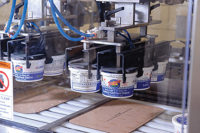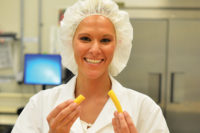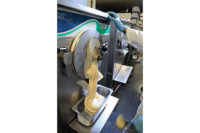Extended shelf life processing
The ESL room is supervised by plant manager Andre Frey-Thomas. There are three half-gallon fillers, one half-pint to quart filler and one plastic bottle filler. The fillers fill paper cartons and plastic bottles. The ESL lines run 24 hours a day for six days. ESL products have a shelf code of 60 to 120 days (depending on the product and packaging), and require refrigeration.
One of the fillers is eight years old and was moved from the East Coast to Sacramento. Even though the filler was operable, “it was really beat up,” Hardy said. The equipment operators asked Hardy if they could clean it up because it looked out of place next to the newer fillers in the room. On their own time, the employees hand-polished the stainless steel to the point where it is now indistinguishable from the newer machines. Hardy bought a new control panel to complete the look.
After filling, the bottles leave the ESL room and are conveyed to a staging area where four robotic palletizers build pallets. This space had been the site of the conventional milk business. Hood had ample room to lay out the palletizers, so nothing is cramped.
A shrink-wrapping machine encases each pallet in plastic and then they are transported to a 48,000-square-foot refrigerated warehouse elsewhere on the grounds. Hood added a fourth pick bay in spring 2012. Four cranes do auto picking from 4,500 pallets. These are turned over every 10 days.
Another room holds an ESL rotary plastic filler. Here, Hood can fill 100 96-ounce bottles a minute or 350 quart bottles a minute. The process starts with sanitizing the bottles. The sanitizer sits in the bottle for a short amount of time, and then the bottle is inverted and rinsed with sterile water. A net weight load cell assures that the containers are filled to within a tolerance of plus-or-minus 1 gram. After filling, a foil seal is sterilized with UV light, and then a sonic welder fits the cap to the gable top.
















